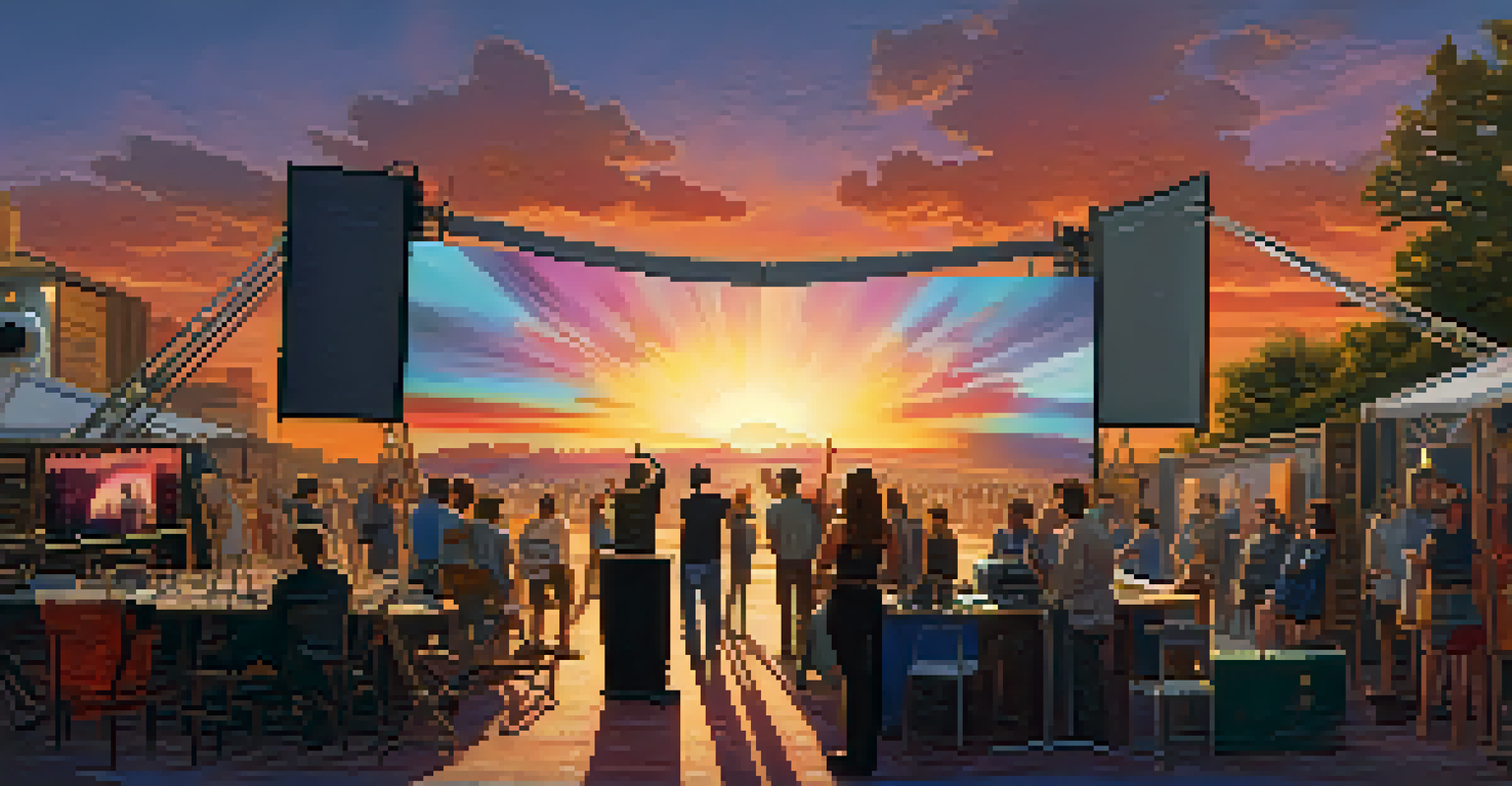Collaboration Between Directors and Screenwriters

Understanding the Roles: Directors vs. Screenwriters
At the heart of any film lies a collaboration between directors and screenwriters, each with distinct yet intertwined roles. Directors are responsible for the overall vision, guiding the actors and crew to bring the script to life on screen. Meanwhile, screenwriters craft the narrative, developing characters, dialogue, and the plot structure that serves as the blueprint for the film.
The art of filmmaking, like any art, is a collaborative effort. It's about merging different visions to create something greater than the sum of its parts.
While directors focus on the visual storytelling and pacing, screenwriters ensure the story resonates with the audience through well-structured writing. This division of labor is essential; without a strong script, even the best directorial vision can fall flat. Think of it like a symphony where the screenwriter composes the music, and the director conducts the performance, ensuring every note hits just right.
Ultimately, both roles require a deep understanding of storytelling and collaboration. This partnership is not just about division of tasks but about merging creative visions to create something greater than the sum of its parts.
The Collaboration Process: From Script to Screen
The journey from script to screen begins with brainstorming sessions where directors and screenwriters exchange ideas. This initial phase is crucial for establishing a shared vision, as both parties must align on themes, tones, and character arcs. It’s during these conversations that sparks of creativity fly, often leading to significant script adjustments and refinements.

As the script evolves, directors provide insights on what visual elements can enhance the story, while screenwriters adapt their writing to accommodate practical limitations. For instance, a director may suggest a location that inspires a change in a character's background, prompting the screenwriter to weave in new details. This back-and-forth dialogue is where the magic happens, allowing both parties to learn from each other.
Collaboration Enhances Filmmaking
The partnership between directors and screenwriters leads to a richer narrative and more engaging films.
Moreover, this collaboration doesn't end once filming begins. Continuous feedback and adjustments during production are common, showcasing the dynamic nature of filmmaking. This fluid process exemplifies how collaboration leads to a more cohesive final product, reflecting the strengths of both the writer and the director.
Communicating Effectively: Key to Successful Collaboration
Effective communication is the lifeblood of collaboration between directors and screenwriters. Both need to express their ideas clearly and openly, fostering an atmosphere where creative input is welcomed. This can often mean setting aside ego and being willing to compromise, allowing the project to evolve in unexpected and beneficial ways.
Great filmmaking is a collaborative process between the director and the writer, both of whom bring their unique visions and skills to the table.
Tools like storyboards, script readings, and collaborative software can streamline this communication, ensuring everyone is on the same page. For instance, a director might utilize storyboards to visualize scenes, helping the screenwriter see how their words translate to action. When both parties actively engage with each other's work, the resulting synergy often leads to innovative storytelling.
Ultimately, it's about building a partnership rooted in trust and respect. When directors and screenwriters communicate effectively, they can tackle challenges together, resulting in a stronger, more impactful film that resonates with audiences.
Navigating Conflicts: Finding Common Ground
In any creative partnership, conflicts are bound to arise, especially in the high-pressure environment of filmmaking. Directors might have a specific vision that doesn’t align with the screenwriter’s intent, leading to tension. However, it's essential to approach these conflicts with the mindset of finding common ground, focusing on what serves the story best.
For example, a director may feel a scene requires more action, while the screenwriter may want to focus on character development. By discussing the underlying motivations for their choices, both parties can work together to craft a solution that satisfies both aspects. This could mean rewriting the scene to incorporate both thrilling moments and deeper character insights.
Effective Communication is Key
Clear and open communication fosters creativity and helps resolve conflicts in the filmmaking process.
Conflict resolution in this realm often comes down to collaboration and compromise, turning potential roadblocks into opportunities for creativity. When handled well, these disagreements can enrich the storytelling process, pushing both the director and the screenwriter to explore new ideas and perspectives.
The Impact of Collaboration on Storytelling Quality
When directors and screenwriters collaborate effectively, the quality of storytelling can significantly improve. This partnership allows for deeper character exploration, richer narrative arcs, and a more engaging viewing experience. By melding their strengths, they can elevate a simple plot into a compelling story that captivates audiences.
Take, for example, iconic films where the director-screenwriter duo created unforgettable characters and moments. The synergy between Quentin Tarantino and his screenwriters showcases this, as their collaborative process has led to films that are both visually stunning and narratively complex. Each element, from dialogue to cinematography, reflects their shared vision, resulting in a cohesive film.
Ultimately, the collaborative effort results in a story that resonates with viewers, allowing them to connect emotionally with the characters and themes presented. This shared goal of creating something impactful drives both directors and screenwriters, making their collaboration not just beneficial but essential for success.
Learning from Each Other: Skill Development
Collaboration between directors and screenwriters is not just about creating a film; it's also an opportunity for personal and professional growth. Each party brings unique skills and perspectives, allowing for a rich exchange of knowledge. This learning process can lead to enhanced storytelling techniques and a deeper understanding of the filmmaking craft.
For instance, a screenwriter may gain insight into visual storytelling by observing how directors interpret their scripts, leading to more concise and visually-oriented writing in future projects. Conversely, directors can learn about the intricacies of narrative structure and character development, making them more effective storytellers in their own right. This reciprocal learning fosters a culture of creativity and innovation.
Conflict Can Drive Creativity
Navigating conflicts with a focus on collaboration can transform challenges into opportunities for innovative storytelling.
Moreover, by collaborating on multiple projects, directors and screenwriters can develop a shorthand or unique language that expedites the creative process. This bond often leads to long-term partnerships, producing an impressive body of work that continues to push the boundaries of film.
Celebrating Successful Collaborations in Film History
Throughout film history, there have been iconic collaborations that have redefined storytelling. Directors like Martin Scorsese and screenwriter Paul Schrader created timeless classics such as 'Taxi Driver,' showcasing how their partnership produced powerful narratives that still resonate today. These collaborations often bring out the best in both parties, leading to unforgettable cinematic experiences.
Additionally, the collaboration between director Christopher Nolan and screenwriter Jonathan Nolan has resulted in mind-bending films like 'Inception' and 'The Dark Knight.' Their ability to blend complex narratives with compelling characters demonstrates the power of collaboration in pushing creative boundaries. It's these partnerships that remind us of the magic that happens when creative minds unite.

As we celebrate these successful collaborations, it's important to recognize the hard work, communication, and shared vision that made them possible. These filmmakers have paved the way for future generations, showing that collaboration can lead to extraordinary storytelling that captivates audiences around the world.